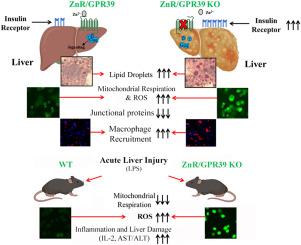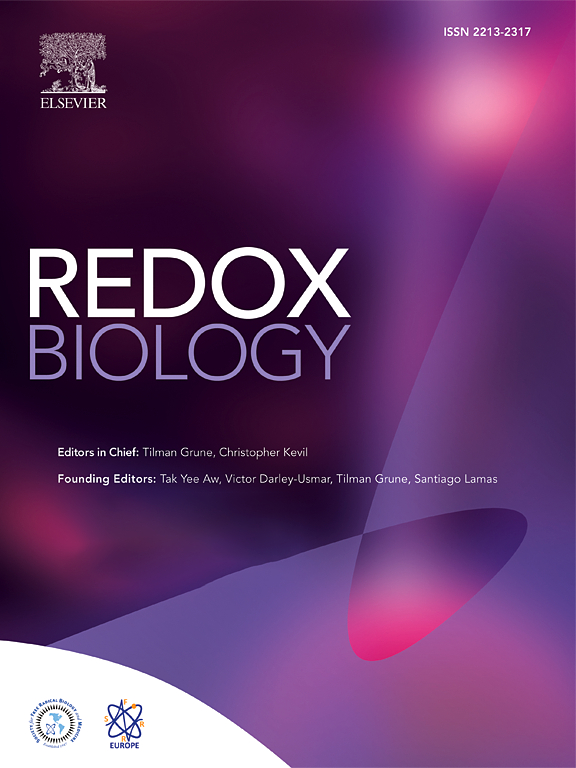ZnR/GPR39 可调节肝脏胰岛素信号,调整肝脏生物能和 ROS 的产生,减轻肝脏纤维化和损伤。
IF 10.7
1区 生物学
Q1 BIOCHEMISTRY & MOLECULAR BIOLOGY
引用次数: 0
摘要
充足的锌供应对肝功能至关重要,缺锌与急性肝损伤(ALI)和慢性非酒精性脂肪肝(NAFLD)有关。然而,锌如何控制肝功能尚不清楚。我们发现,锌敏感的 ZnR/GPR39 是锌信号转导的介质,它能增强肝脏中 ERK1/2 的磷酸化,而在 ZnR/GPR39 缺乏的肝脏中,ERK1/2 的磷酸化会降低。令人惊讶的是,ZnR/GPR39基因敲除(KO)小鼠的肝脏表现出胰岛素受体表达和下游AKT激活的升高。此外,ZnR/GPR39 KO 小鼠的空腹血糖水平较高,肝脏脂质蓄积明显,肝细胞耗氧率(OCR)和活性氧(ROS)水平升高。这些数据表明,ZnR/GPR39 可调节胰岛素受体信号传导,而胰岛素受体信号传导是肝脏代谢的主要途径。与信号传导受损有关的是,与野生型(WT)相比,ZnR/GPR39 KO 肝脏表现出组织纤维化加重,表现为胶原蛋白表达明显升高。此外,我们还发现 ZnR/GPR39 KO 小鼠的肝细胞连接蛋白发生了改变,同时巨噬细胞浸润增加,肝脏炎症加剧。为了确定 ZnR/GPR39 在 ALI 中的作用,我们应用了温和的 LPS 挑战,该挑战诱导肝脏 OCR 显著下降,同时导致 ZnR/GPR39 KO 小鼠肝细胞产生更多的 ROS,而 WT 小鼠则没有。我们进一步发现,只有 ZnR/GPR39 KO 小鼠的血清 IL-2 和 AST/ALT 比值升高。我们的研究结果揭示了 ZnR/GPR39 在控制肝脏胰岛素受体信号传导、减轻肝纤维化和炎症方面的作用,从而强调了 ZnR/GPR39 在肝脏信号传导和功能中的重要作用。本文章由计算机程序翻译,如有差异,请以英文原文为准。

ZnR/GPR39 regulates hepatic insulin signaling, tunes liver bioenergetics and ROS production, and mitigates liver fibrosis and injury
Adequate supply of zinc is essential for hepatic function and its deficiency is associated with acute liver injury (ALI) and chronic nonalcoholic fatty liver disease (NAFLD). However, how zinc controls hepatic function is unknown. We found that the zinc sensitive ZnR/GPR39, a mediator of zinc signaling, enhances hepatic phosphorylation of ERK1/2, which is reduced in ZnR/GPR39 deficient livers. Surprisingly, livers from ZnR/GPR39 knockout (KO) mice exhibited elevated insulin receptor expression and downstream AKT activation. Moreover, ZnR/GPR39 KO mice had higher blood fasting glucose level, pronounced hepatic lipid accumulation, increased hepatocyte oxygen consumption rate (OCR) and reactive oxygen species (ROS) levels. These data suggest that ZnR/GPR39 modulates insulin receptor signaling, a major pathway in hepatic metabolism. Associated with the impaired signaling, ZnR/GPR39 KO livers exhibited increased tissue fibrosis, manifested by marked elevation of collagen expression, compared to wildtype (WT). Additionally, we found alteration of hepatocyte junctional proteins that was accompanied by increased macrophage infiltration and higher liver inflammation in ZnR/GPR39 KO mice. To determine the role of ZnR/GPR39 in ALI, we applied a mild LPS challenge that induced profound decrease in hepatic OCR, also leading to higher ROS generation in ZnR/GPR39 KO hepatocytes, but not in WT. We further found increased serum IL-2 and AST/ALT ratio only in ZnR/GPR39 KO mice. Our findings reveal a role of ZnR/GPR39 in controlling hepatic insulin receptor signaling and mitigating liver fibrosis and inflammation, thus underscoring the important role of ZnR/GPR39 in liver signaling and function.
求助全文
通过发布文献求助,成功后即可免费获取论文全文。
去求助
来源期刊

Redox Biology
BIOCHEMISTRY & MOLECULAR BIOLOGY-
CiteScore
19.90
自引率
3.50%
发文量
318
审稿时长
25 days
期刊介绍:
Redox Biology is the official journal of the Society for Redox Biology and Medicine and the Society for Free Radical Research-Europe. It is also affiliated with the International Society for Free Radical Research (SFRRI). This journal serves as a platform for publishing pioneering research, innovative methods, and comprehensive review articles in the field of redox biology, encompassing both health and disease.
Redox Biology welcomes various forms of contributions, including research articles (short or full communications), methods, mini-reviews, and commentaries. Through its diverse range of published content, Redox Biology aims to foster advancements and insights in the understanding of redox biology and its implications.
 求助内容:
求助内容: 应助结果提醒方式:
应助结果提醒方式:


